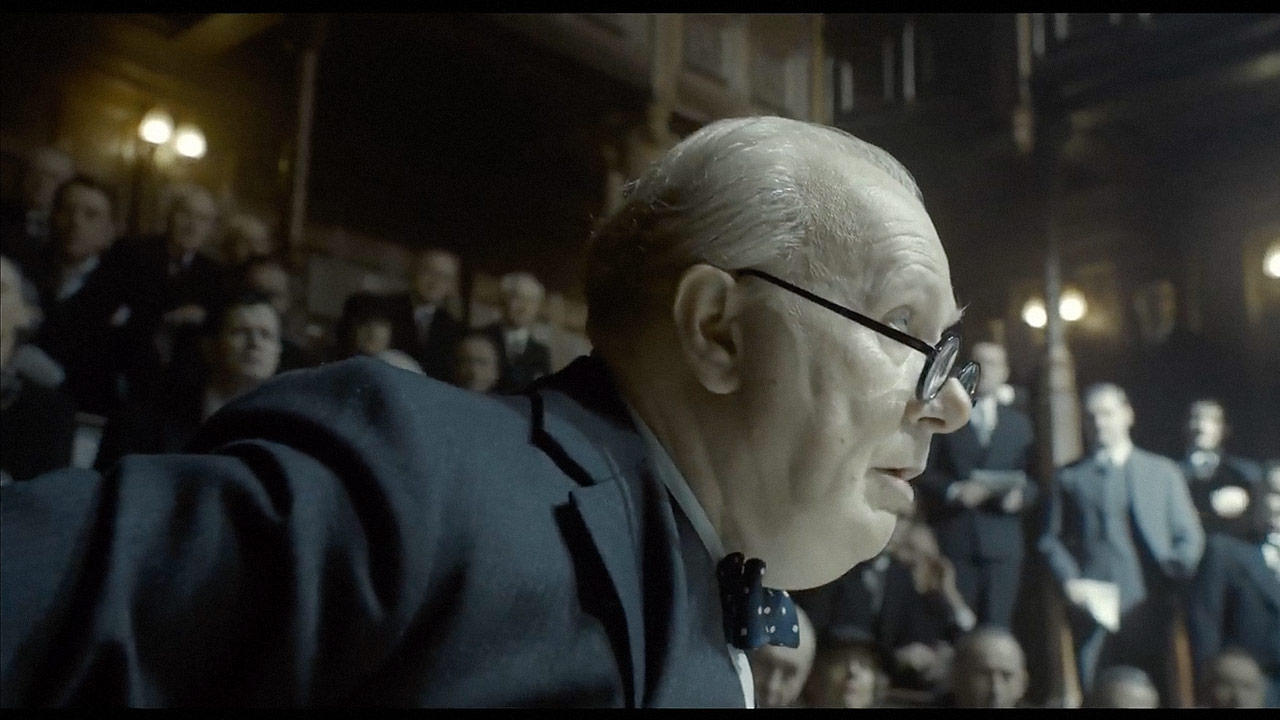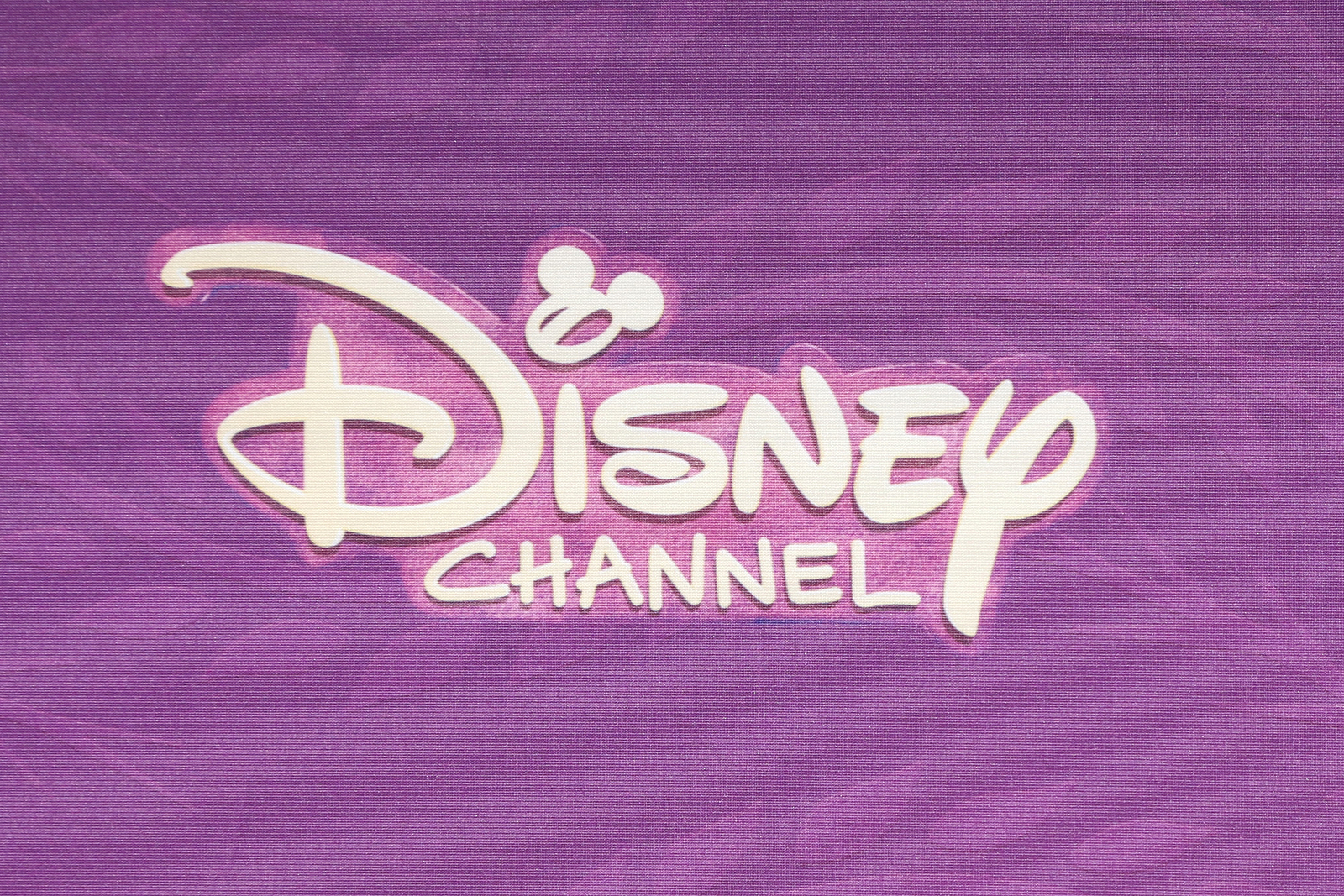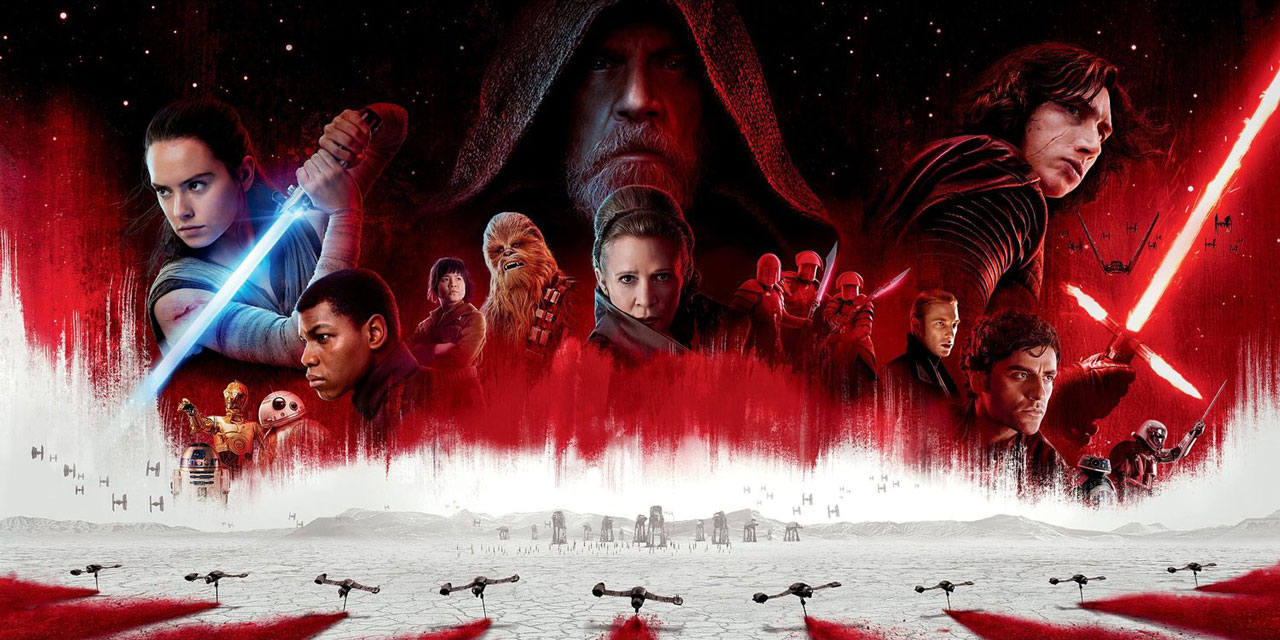
by Michael Foust | Dec 29, 2017

Nazi Germany is on the move, but everyone in 1940 Britain can rest easy. Winston Churchill is finally at the helm as prime minister.
If it were only that simple.
The courageous and resolute Churchill we’ve learned about in history books is certainly courageous and resolute in Darkest Hour (PG-13) – a biographical movie now in theaters – but he has few supporters.
“We have a drunkard at the wheel,” says one member of Parliament.
“I wouldn’t let him borrow my bicycle,” says another.
Even King George VI doesn’t trust Churchill, instead supports his rivals, including predecessor Neville Chamberlain.
“Winston lacks judgment,” the king says.
The fretting is no small matter. Hitler has conquered most of Western Europe and is on the verge of occupying France. Britain, likely, is next. As we learn in Darkest Hour, Chamberlain and a handful of powerful MPs – all members of Churchill’s own party – are plotting to remove him from power. Their goal: Sign another peace agreement with Hitler and hope for the best. Churchill, though, is determined to go down fighting – even though his entire army is surrounded on the beaches of Dunkirk, France.
“You cannot reason with a tiger when your head is in its mouth!” he tells his own party.
Darkest Hour stars Gary Oldman (The Dark Knight) as Churchill; Kristin Scott Thomas (Four Weddings and a Funeral) as his wife, Clemmie; Ben Mendelsohn (Rogue One, The Dark Knight Rises) as King George VI; and Lily James (Cinderella, Downton Abbey) as Churchill’s young secretary, Elizabeth Layton.
It’s one of the most inspiring biographies I’ve seen, and it succeeds largely because it depicts elements of Churchill’s story many Americans don’t know. He came to power following a coup and then nearly was toppled in a coup. He had to fight isolationist and dove-like tendencies within his Conservative Party, despite the ominous threat from Hitler. And he was a man full of weaknesses, including fear and doubt.
Of course, like any Hollywood film based on real events, it’s full of some fiction, too. Stay tuned for those details.
Warning: spoilers!
Violence/Disturbing
Minimal. For a film based on a war era, there is a surprising lack of violence. That’s because most of the scenes take place in Parliament, in Churchill’s home, or on the streets of Britain. But we do watch several bombs drop, and we do see a field hospital with several wounded men. We also hear talk of war strategy, including whether some men should be sacrificed so a larger number will survive.
Sexuality/Sensuality/Nudity
Minimal. We hear Churchill in the bathtub, and we then see the bottom half of his bear legs walk across the floor.
Coarse Language
Minimal. I counted only a handful of coarse words: d—n (3), misuse of God (2). There are also several uses of British words such as “bloody,” “bum” and “bugger.” The phrase “up your bum” is heard a few times in one scene in reference to something Churchill naively did in a newspaper picture (He showed photographers a backwards peace sign, which at the time was considered vulgar).
Other Positive Elements
The love between Churchill and his wife is obvious. During one poignant scene after he makes his secretary cry, his wife scolds him and says: You aren’t as nice as you once were. “You’ve become rough… I want others to love and respect you as I do.”
To his credit, Churchill learns to treat his young secretary gentler, and they become a good team.
During his speeches, we also hear a couple of references to God.
Other Negative Elements
Churchill smokes (cigars) often, drinks often and eats a lot of unhealthy food, too. When the king asks him how he manages to drink so much – including drinking in the morning – Churchill answers, “Practice.”
Other Stuff You Might Want To Know
The film’s overarching message is true to history, but some of the scenes are fictional. Specifically, a scene in which Churchill boards a subway and talks to everyday British citizens – a scene that led me to tears – is fictional.
Life Lessons
The on-screen Churchill provides us lessons on courage, determination, steadfastness and overcoming fear and doubt. It also gives us a solid example on opposing evil.
Worldview
When Christians debate the necessity of war, World War II is often cited as an example of a just war. Consider: A murderous mad man was marching across Europe, killing indiscriminately and wiping out an entire ethnic class. What would the world look like today if Britain and Churchill hadn’t stood firm?
War is a terrible thing, but in a fallen world, it is sometimes necessary (Ecclesiastes 3:8). After all, one of the primary responsibilities of government is to protect its citizens (Romans 13:1-4). Sometimes, such efforts won’t be successful, but thankfully during the 1940s, it was.
The movie also tosses a few ethical dilemmas our way. For example, Churchill must decide if he will send a group of 4,000 soldiers to their near-certain death in order to distract the Germans and protect 300,000 men at Dunkirk.
What I Liked
Learning about the real Churchill – the one who had everyday struggles just like the rest of us. Additionally, the Parliament scenes are impressive. I also enjoyed the back-and-forth between Churchill and those around him, including his wife, his secretary and the king. Oldman and James are marvelous in their roles.
What I Didn’t Like
The overtly fictional stuff that was inserted into the film. Churchill’s story is already entertaining. Why make something up?
Family-Friendly?
Darkest Hour is suitable for older children, provided parents don’t mind them hearing discussions of war and a few British slang words. Younger children likely would be bored.
Thumbs Up … Or Down?
Thumbs up.
Discussion Questions
- Was World War II necessary and justified? Explain your answer.
- Name a war you believe wasn’t a just war.
- Why was Churchill so persuasive? And why did he intimidate people?
- What did you think about Churchill’s health choices – specifically his smoking and drinking?
- Did Churchill make the right choice?
- Do fictional scenes in biographical movies trouble you? Why or why not?
Entertainment rating: 4 out of 5 stars. Family-friendly rating: 3.5 out of 5 stars.
Darkest hour is rated PG-13 for some thematic elements.

by Michael Foust | Dec 22, 2017
Robin Williams’ 1995 version of Jumanji was considered mostly family-friendly, with few language concerns and zero sexuality. By contrast, the newest Jumanji is filled with so much coarse language and crude sexual jokes that moms and dads might consider walking out of the theater.
Martha, Bethany, Fridge and Spencer are an eclectic group of high school students with only one thing in common: They’re all serving in detention.
That’s what happens when you smart off to the teacher (as Martha and Bethany did) or cheat on a paper (Fridge and Spencer). You’re then forced to clean out the school basement, which is filled with old newspapers, magazines and electronics, including a 1990s-era video game system with a cartridge titled “Jumanji.”
Faced with cleaning the basement or wasting time with a joystick, our unsupervised foursome does what most any group of teens would do. Play the video game!
But they soon discover that this is no ordinary game. It has magical powers, and within seconds they’re sucked into the game and battling for survival in a wild jungle. And instead of remaining in their bodies, they’re adjusting to a new life in the bodies of their avatars.
Jumanji: Welcome to the Jungle (PG-13) opens in theaters this week, 12 years after Robin Williams starred in the first Jumanji movie and 36 years after Chris Van Allsburg’s Jumanji children’s book was released.
It stars Dwayne Johnson as Spencer, Kevin Hart as Fridge, Jack Black as Bethany (her avatar is a middle-aged male) and Karen Gillan as Martha.
Despite having a few good messages, Jumanji: Welcome to the Jungle is very different from its predecessor. Robin Williams’ 1995 version was considered mostly family-friendly, with few language concerns and zero sexuality. By contrast, the newest Jumanji is filled with so much coarse language and crude sexual jokes that moms and dads will be blushing – if not walking out of the theater, too.
Four male writers and a male director teamed up on this one, which explains the film’s crude infatuation with the female anatomy and its not-so-subliminal message: Women are merely sex objects. Yes — surprise, surprise — Hollywood has ruined another fun, fantasy franchise.
Most of the comedy falls flat, primarily due to its sophomoric focus on sex and body parts. An immature fifth-grade boy could have written it. (Meanwhile, if you’re looking for a creative PG-13 comedy, watch Logan Lucky.)
Ready for the details?
Violence/Disturbing
Moderate. Each of the characters in the video game has three lives. When one person dies, he or she disappears, and the new person/life then falls from the sky. It sounds gruesome, but it’s mostly bloodless. Bethany dies in one instance when a hippo eats her. Later, Fridge gets trampled by hippos. Bad guys on motorcycle shoot at the foursome, with machine guns and missiles. Fridge and Spencer punch one another several times. We see a large snake. In perhaps the most disturbing scene, we watch a scorpion crawl out of a man’s mouth and bite another man, killing him. A large jaguar chases the group.
Sexuality/Sensuality/Nudity
Excessive. Jumanji contains no nudity, but plenty of everything else in this category. Martha (in her new female body) sports a belly-revealing outfit and short shorts throughout the film. Bethany (in her male body) tells herself as she tries to gain confidence: “You can hook up with whoever you want.” She jokes about going to school in a bikini and flashing skin. There’s a joke about breasts, and two jokes about sex that I won’t print here. Bethany (in her male body) teaches Martha (in her new female body) how to flirt with guys and walk provocatively. We then see Martha do exactly that, awkwardly. There are multiple jokes among the group about the male anatomy, including a lengthy, uncomfortable scene in which Bethany (in her male body) is forced to urinate in the jungle. The two men in the group teach her how to do it. Outside the jungle, Bethany shows various amounts of skin at school, including in a belly-revealing outfit in gym class. Two characters kiss twice.
Coarse Language
Excessive. I counted about 55 coarse words: H-ll (16), a– (13), OMG (20), d–n (2), s–t (2), misuse of “Jesus” (1) and b–ch (1).
Positive Elements
We get a peek at the home life of Fridge and Spencer and their respective moms. Each seems to have parents who truly love them.
The film has a solid anti-clique message (see below).
Other Stuff You Might Want To Know
Fridge enjoys drinking alcohol, and he gets drunk. Bethany, in the real world, is addicted to her social media account. She posts a staged picture of her waking up, and then frets because a certain boy never “likes” it. Spencer and Fridge collude to cheat, with Spencer writing a paper for him; they get caught.
Life Lessons
Mixed in with the muck are lessons on overcoming fear, getting out of one’s comfort zone, not bullying, and not judging on appearance alone. Meanwhile, our heroes – comprised of an athlete, a popular pretty girl, and a couple of other teens who don’t fit in – learn to break down the social walls at school and mix with people outside their cliques.
Worldview
The new Jumanji film takes place inside a fantasy world ruled by spirits.
But the film’s message about cliques – which dominate high schools across the country — deserves the most attention. As Christians, we know cliques are unhealthy, unbiblical and even riddled with sinful thoughts. Taken too far, cliques promote an “us” vs. “them” mentality and are void of love for others.
Jesus, of course, broke down the walls within the church, telling us there should be no divisions (1 Cor. 1:10). That is ultimately possible only with the power of Christ. It is something we should strive toward in every realm of society – inside the church and inside our schools.
Family-Friendly?
Jumanji: Welcome to the Jungle is not family-friendly.
What I Liked
The messages about cliques and breaking down barriers.
What I Didn’t Like
The humor. Some of it is funny. Most of it is not.
Thumbs Up … Or Down?
Thumbs down.
Discussion Questions
- Why do we form cliques? How can we overcome them?
- Name some creative ways we can reach out to people different from us.
- Each member of the group learned to get outside its comfort zone. What are some ways God might want you to get outside your comfort zone?
- What did you think about the movie’s view of women and sexuality?
Entertainment rating: 2 out of 5 stars. Family-friendly rating: 2 out of 5 stars
Jumanji: Welcome to the Jungle is rated PG-13 for adventure action, suggestive content and some language.

by Michael Foust | Dec 19, 2017
It never was a good idea to let your children watch the Disney Channel without some parental input or supervision, but now it’s a downright bad one.
The series Andi Mack in October became the first Disney Channel series to feature an openly gay main character when Cyrus – a 13-year-old male character – confided that he has romantic feelings for boys.
It was but the latest “gay moment” for the Disney Channel, which in June aired an episode of The Lodge in which a minor character came out as gay. And earlier this year on Disney XD, the cartoon series Star vs. The Forces of Evil included a concert scene where men were kissing men, and women kissing women.
What’s a Christian parent to do? Here are a few thoughts:
- Teach our children to be discerning. Sure, we can just “turn it off,” but Scripture wants us to do much more (Deut. 6:6-7). We must teach our children the whole counsel of God – and how it applies to life. After all, we want our children to make the right decisions when we aren’t in the room.
- Acknowledge that it’s not harmless entertainment. Consider: What is Disney’s goal in inserting gay characters? It is to normalize homosexuality. It’s virtually an advertisement. No doubt, some teens and children are mature enough to watch such content and remain firm in their faith. Others, though, are not. Only parents can decide.
- Consider alternatives. I gave up on broadcast and cable television long ago. Nothing surprises me. That’s why my family has opted for streaming alternatives: the good shows on Netflix, along with services like the Dove Channel, PureFlix, ClearPlay and VidAngel. That way, we get to decide on the content. And it’s a lot more inspiring, too.

by Michael Foust | Dec 15, 2017
When the first Star Wars movies were released four decades ago, it was easy to avoid spoilers and leaks. There was no Facebook or Twitter. There wasn’t even an Internet. As long as you stayed away from newspapers and magazines, you were fine.
Nowadays, though, it’s not so easy. In fact, it’s downright difficult.
For the last few weeks, I have avoided all news about The Last Jedi. I haven’t even read headlines. Why? Because I wanted to be as surprised by the twists and turns on opening night as I was back in 1980 when Darth Vader said those famous words: “I am your father.”
I know I’m not the only one like that. But there’s a problem with this strategy. If we know nothing about the movie, then how are we to know if we should take our children? Sure, we could study the movie’s rating – it’s PG-13 – but those are often as useful as a wet paper bag.
That’s where this review comes in handy. In the next few paragraphs, I’ll give you a broad overview of the content in The Last Jedi without revealing a single surprise, spoiler or plot. I won’t even tell you what the opening scroll says.
And in the final paragraph, I’ll tell you if I liked it or not. I’ll also reveal where it ranks in my list of all nine Star Wars movies. Ready?
Violence/Disturbing Content
Moderate. The violent/disturbing content in The Last Jedi is on par with The Force Awakens and Return of the Jedi, and less than that in Revenge of the Sith. One particular character is as spooky as the Emperor, and we see him several times.
There are multiple space battles and some light saber duels, too, but the violence remains bloodless. One character slaps another character.
I took my 9-year-old son to watch The Last Jedi. I’m not sure I’d take my 6-year-old son. Maybe. If kids aren’t bothered by The Force Awakens or Return of the Jedi, then they’ll be fine in The Last Jedi.
Sexuality
None. A female character gives a male character a peck on the lips. A male character is seen shirtless.
Language
Minimal. I counted six coarse words: h-ll (2), da—it (1), d—n (1), ba—ard (1), a—(1). While minimal, it is a record number of swear words for a Star Wars film. That’s disappointing, even if the language often is in noisy scenes where kids might not notice. (If you’re curious: Rey curses once; Poe and Finn say the other words.)
Other Stuff You Might Want To Know
There’s a bar/casino scene, where we see drinking and gambling.
On the positive side, though, The Last Jedi continues its racial diversity trend with a prominent (and new) Asian character. There also are female pilots on the good side.
Life Lessons
Self-sacrifice, courage and determination are the primary lessons.
Worldview
We see characters do never-before-seen things with the Force, which we are told is the “energy between all things” that binds the “universe together.” That sounds a lot like pantheism, the unbiblical belief that holds that everything and everyone is “god.” Hinduism and some strands of Buddhism are pantheistic. In this film, the Jedi teachings also are called a “religion.”
There is no personal God in the Star Wars universe – something that might be worth discussing on the ride home.
Sponsors
For children, General Mills – which makes several popular cereals — is the most prominent sponsor.
Family-Friendly?
It’s family-friendly for teens and most older children. As for younger kids, that’s a parental decision.
Thumbs Up … Or Down?
Thumbs up.
Final Verdict
The first hour of The Last Jedi was slow at times – so much so that I was losing hope in this newest installment. But the final hour more than made up for it. In fact, the final hour is as good as any 60-minute stretch in any Star Wars film, as it includes multiple surprising twists.
I’ll tentatively place The Last Jedi No. 4 on my list of Star Wars movies. My full list: 1. The Empire Strikes Back, 2. A New Hope, 3. The Force Awakens, 4. The Last Jedi, 5. Return of the Jedi, 6. Rogue One, 7. Revenge of the Sith, 8. The Phantom Menace, 9. Attack of the Clones.
Entertainment rating: 4.5 out of 5 stars. Family-friendly rating: 3.5 out of 5 stars.
The Last Jedi is rated PG-13 for sequences of sci-fi action and violence.

by Michael Foust | Dec 7, 2017
He’s the meanest creature on the planet, but perhaps that’s to be expected. After all, his heart is “two sizes too small.”
He enjoys sending nasty letters to the people in the next town. He gets jollies out of stealing presents. He even eats glass.
The Grinch—who lives on an intimidating mountain overlooking the kind people of Whoville—just may be the most unlovable “thing” ever made. But not everyone agrees.
Little Cindy Lou Who—a bright-eyed young girl from Whoville—believes the Grinch is capable of good. She even claims he saved her life!
So, when the townspeople push back against Cindy Lou’s claims about the Grinch, she launches an investigation. What she finds is shocking: Long ago, a younger Grinch was (heavily) bullied by the kids of Whoville. He subsequently left town and climbed up the mountain, and the people haven’t heard from him since. Perhaps that’s why he is so mean. And maybe if someone is kind to him, he will return the favor.
It’s all part of “Dr. Seuss’ How the Grinch Stole Christmas” (PG), the highest-grossing film of 2000 and one of the top choices for Christmas-themed streaming selections in December. It is playing on Netflix.
This delightful and mostly family-friendly film was directed by Ron Howard and stars Jim Carrey as the Grinch. It also won an Oscar (Best Makeup).
Although purists of Dr. Seuss’ books might be troubled by some of the additions, it nevertheless maintains messages on kindness and redemption. The bullying angle gives it a timely 21st-century lesson. It does contain a few scary parts that might trouble young children, and one or two slightly inappropriate scenes.
Among other Christmas-themed selections this month:
Netflix
“White Christmas” (1954, unrated)—This musical-comedy about a pair of singing-and-dancing men won an Oscar (Best Song) and stars Bing Crosby, Danny Kaye and Rosemary Clooney.
Also playing: Lots of Hallmark-type romantic Christmas specials. Just type “Christmas” into Netflix. Enjoy!
Amazon Prime
“Charlie Brown’s Christmas Tales” (2002, unrated)—This isn’t the “Charlie Brown Christmas” that we all love, but for 20 minutes of entertainment with Snoopy, it’s not bad. Just don’t expect a Gospel message.
“I Want a Dog for Christmas, Charlie Brown” (2003, unrated)—Ever heard of Snoopy’s brother Spike? He’s featured in this one—and he’s hilarious.
“If You Give A Mouse A Christmas Cookie” (2016, unrated)—Based on the popular series of children’s books, this cartoon likely will have your kids cackling in the floor.
“Christmas with the Kranks” (2004, PG). In this comedy, a family decides to skip Christmas and go on a cruise. It doesn’t go well. Starring Tim Allen and Dan Aykroyd. Rated PG for brief language and suggestive content.
Also playing: Lots of old Christmas cartoons that haven’t aired on television in several decades. Search for “Christmas cartoons.”
Hulu
“Christmas with the Kranks” (2004, PG). See above. Otherwise, it’s a slow month for Christmas classics/family-friendly entertainment on Hulu.
Note: The 1965 classic “A Charlie Brown Christmas” is not available on any of the major streaming services. But it often is available on YouTube.





